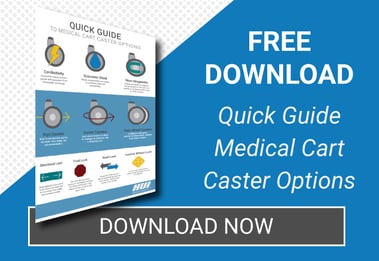The choice of caster used on your medical cart has a huge impact on maneuverability, staff comfort, safety, and compliance for your medical device system. Scroll through a website or leaf through a catalog from any caster manufacturer, and you'll see lots of options. Where do you start?
We've broken down some common caster options and terms for you to get you started. From there, you can make some informed decisions about the right caster for your project. You can download our "Quick Guide to Medical Cart Caster Options" Infographic or read on for more info!
Let's start with some questions that will help you get you "rolling".
Where will the medical device be used?
Certain environments will require specialized features on the casters of your cart.
For example, carts meant to carry sensitive electronic medical devices safely in lab areas may require ESD management. For this type of cart, we would source conductive casters to prevent equipment malfunctions and static shocks.
Another environment that requires specialized casters is the MRI room. Any magnetic material can interfere with the safe use of the MRI machine, and suppliers offer all-plastic non-magnetic casters for this use.
Finally, sanitization of carts and devices means that casters will be exposed to water. Casters built for washability are made with all stainless steel metal parts to avoid rust and corrosion.
How does the cart need to be moved?
Balance maneuverability and stability to get your cart where it needs to go.
The two main movement types of casters are rigid casters and swivel casters. Rigid casters (also called fixed casters) allow the medical device to be moved back and forth on a straight path. This makes the cart very stable, since it will not swerve, but naturally makes it less maneuverable. In some cases rigid casters may be combined with swivel casters on the same frame.
Swivel casters, of course, allow for rotation of the wheel and can change direction during movement. This offers greater mobility during transport and finite adjustments in the area where the medical device will be used. But we've all had the experience of trying to maneuver a loaded grocery cart to the checkout...
Finally, for ultimate stability and safety in large loads, there is the twin-wheel caster. The dual-mounted wheels reduce tipping hazards, displace the weight of the cart if it rolls over a cord (or a toe!), and are not likely to get stuck in gaps like elevator doorways.
What locking options are needed?
It's likely you need the casters to lock for IEC 60601-1 3rd ed. compliance... but consider usability as well!
In our infographic, we've highlighted four common locking mechanism options common for casters used in medical device carts.
A directional lock disables the "swivel" movement from a wheel to allow it to move back and forth only.
A total lock is just what it sounds like... it prevents the wheel from both rolling and swiveling.
A dual lock gives the operator the option for directional locking or total locking on each individual wheel.
A central wheel lock allows the operator to lock all wheels simultaneously.
This post is by no means exhaustive. When it comes to castors, the features, sizes, and options are nearly infinite. If you want to hear more information and examples straight from our team, check out episodes 11 and 12 of "What's Up With Nick and Chuck" on our YouTube channel!
Looking for even more details about casters and how they relate to IEC 60601-1 3rd ed. compliance? We've got a couple more posts you'll want to check out linked below:
Does Your Custom Medical Cart Need Conductive Casters?
Why IEC 60601-1 3rd Edition Testing Takes Locking Casters into Consideration

